

For more than a decade, forests across much of Chile have been experiencing a megadrought, its effects overprinted on an already warming and drying climate. High in the Andes, stands of giant Nothofagus obliqua trees, also known as roble or southern beech, are stretching themselves to survive—and bucking a global forest trend.
Many trees have experienced decreased growth rates, but some Chilean beeches, which can grow to heights of 40 meters (131 feet), have not. However, researchers report in a new study, not all stands stand equal chances of success in coping with the climate.
Urrutia-Jalabert et al. studied five stands of N. obliqua across a 500-kilometer-long section of the Chilean Andes that spans both Mediterranean and temperate climates. The researchers analyzed carbon and oxygen isotopes in the trees as well as the widths of tree rings dating from 1967 to 2017. These indicators reflect the amount and source of precipitation a tree has received, and together they can reveal how a tree has survived.
Isotopic data suggested that the most resilient N. obliqua stands maintained steady growth rates by pulling moisture from deeper water sources and keeping their leaves’ stomata more closed, which minimizes water loss while taking in necessary carbon dioxide. Both mechanisms were important, the researchers found.
One stand of beeches in a temperate region, for example, showed exceptionally efficient water use with its leaves, but the trees’ growth rates still dropped, likely because of limited water availability in the soil, the authors said. The most resilient stand, farther north in a Mediterranean climate, used both mechanisms to keep growing.
Sourcing deeper water might be only a temporary fix, however. As droughts become longer, more frequent, and more severe, those reserves may run dry. In addition, trees relying on deeper water may receive fewer nutrients, stymieing their development even if they are getting enough water.
So although some trees have successfully adapted to drought in the short term, it’s unclear how long they’ll be able to continue.
The paper is published in the Journal of Geophysical Research: Biogeosciences.
More information:
Rocío Urrutia‐Jalabert et al, Ecophysiological Responses of Nothofagus obliqua Forests to Recent Climate Drying Across the Mediterranean‐Temperate Biome Transition in South‐Central Chile, Journal of Geophysical Research: Biogeosciences (2023). DOI: 10.1029/2022JG007293
Provided by
American Geophysical Union
This story is republished courtesy of Eos, hosted by the American Geophysical Union. Read the original story here.
Citation:
Short-lived solutions for tall trees in Chile’s megadrought (2023, May 31)
retrieved 31 May 2023
from https://phys.org/news/2023-05-short-lived-solutions-tall-trees-chile.html
This document is subject to copyright. Apart from any fair dealing for the purpose of private study or research, no
part may be reproduced without the written permission. The content is provided for information purposes only.